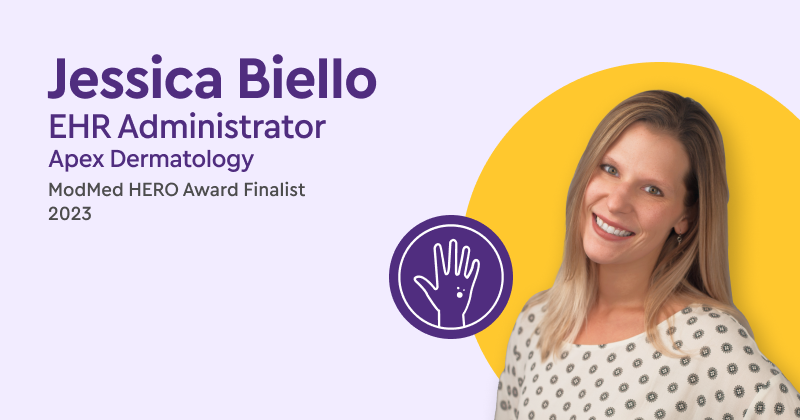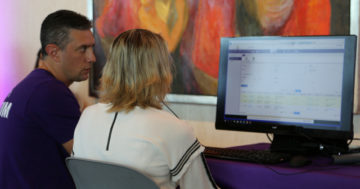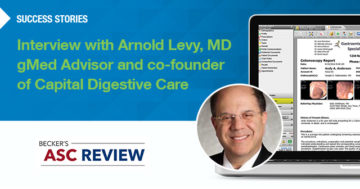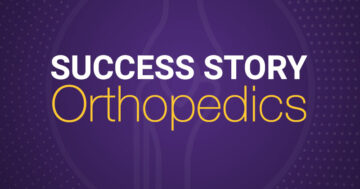Meet EHR Administrator Jessica Biello

Learn how she rallied her team to implement a new EHR system and improve workflows across 14 locations
The ModMedⓇ HERO Award recognizes leaders in practice operations who harness our solutions to help improve their practice. Under her leadership, award finalist Jessica Biello’s practice successfully implemented ModMed across multiple locations and improved workflows in each department. Learn more about her career and accomplishments as an EHR Administrator.
Jessica’s Story
I started out my career in healthcare as a medical assistant in hair restoration, and then I moved up to supervisor. I was looking for a new way forward, so I found a position at Apex Dermatology as Practice Manager of Operations for five offices at the time. Since then, I’ve helped in human resources, recruiting efforts and payroll.
I’ve been at Apex Dermatology for almost seven years, but I wanted to improve the practice from a technology perspective, which is what initially attracted me to my current role as EHR Administrator. We started looking at new EHR systems when we noticed our previous system’s challenges. We realized there had to be something better out there, so we chose ModMed because we felt the clinical side had been mastered.
Apex Dermatology is a 14-location practice with offices across Ohio. They provide medical, cosmetic and aesthetic dermatology services, along with body contouring and Mohs surgery. Additionally, the Apex Clinical Research Center arranges access to clinical trials for patients and to advance the field of dermatology.
They wanted somebody to not just help manage our system, but to determine if we’re getting the most out of our investment and if we’re using all of the capabilities properly. With my familiarity working in different areas of Apex Dermatology’s business, I thought it would be a fun challenge.
Creating a Task Force and Getting Provider Buy-In
Firstly, I created what you might call “clinical workflows” and “front desk workflows” in EMA®, the EHR, and PM system. But, I also took the time to create workflows for the company overall. We have every workflow tested and listed on a shared drive. I developed these through extensive testing and creating a task force including team members from different departments.
I set up mock trainings where myself, a biller, a practice manager and a clinical representative would get together and work through different scenarios, one by one. What is the best way to perform a certain task from beginning to end throughout the entire clinic? We would discuss and challenge one another about which method was better, and why. Each person involved was a strong performer in their respective department and able to provide accurate feedback. Through that process, we could decide on and test the best workflows that fit each area of the business’s needs.
Beyond the task force, I dug deeper into each department to investigate what worked well and what didn’t. That’s how I was able to initiate a partnership with the providers to further improve our processes. I scheduled one-on-one meetings with each provider because I wanted to create personalized scheduling templates in the Practice Management system.
For example, some providers didn’t want to see more than two skin checks back-to-back, or some didn’t want to see more than two new patients per day. So I created a template in front of them and explained it. I walked them through how the template is set up, the parameters, and the space allotted for “x amount” of patients per day. I think partnering with them and then spending that one-on-one time really helped make a difference. In this way, I was able to meet the metrics of the company, and also to help the providers meet those metrics while taking their needs into account.
Time Savings Across the Board
After implementation, we noticed measurable time savings across departments. Training time on our software has decreased significantly. We end up spending 24-48 hours training new hires across the board, whereas with our previous system, training would take about two weeks. When the pandemic hit, we transitioned to digital check-in forms. Going from scanning in paper forms to letting patients complete them on their phones electronically saved time in the waiting rooms.
“Training time on our software has decreased significantly. We end up spending 24-48 hours training new hires across the board, whereas with our previous system, training would take about two weeks.”
We had documentation templates in our previous EMR. ModMed transforms templates into protocols, which are more powerful and customizable to the provider. They’re also much more specific and help cut down on documentation time. Our providers are able to see more patients and spend more time with the patient actually talking to them. It’s easier for staff to assist and easier for the provider to edit, so the increased time spent interacting with patients has made a huge impression on us.
At the front desk, the check-in and checkout processes are much faster. ModMed has the appointment flow set up so that everything the staff needs is on one screen, quick and easy to see. It’s much more user-friendly for our front desk staff than our previous system.
Advice to Improve a Software Rollout
You can’t do this without a team. If you don’t have a team, you won’t be successful. Pick your team wisely, and then figure out and play to each person’s strengths, because you need to be the one to lead them. Get people from different groups. Don’t have an entirely clinical team. You need to have some different biases and opinions in the mix, because you want to be challenged.
I think partnering with providers is another critical step. I would recommend building those relationships because sometimes, they’re not as involved as they should be. When you build trust and partnership with your providers, the entire rollout is better received. People aren’t just being told to do something because you said so. They participated in the process and had some of their challenges addressed and problems fixed, which makes them feel heard.
Learn more about our ModMed HEROs.
The statements and conclusions contained herein reflect the opinions of Jessica Biello and not those of ModMed. ModMed makes no representations or warranties as to the accuracy of any such information. Results may vary depending on medical practice size, product usage and other variables.


